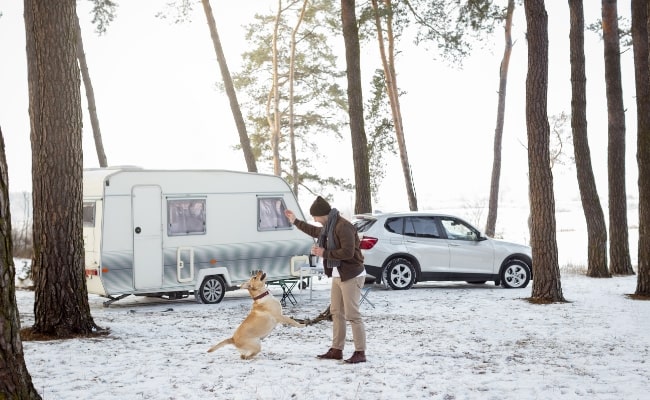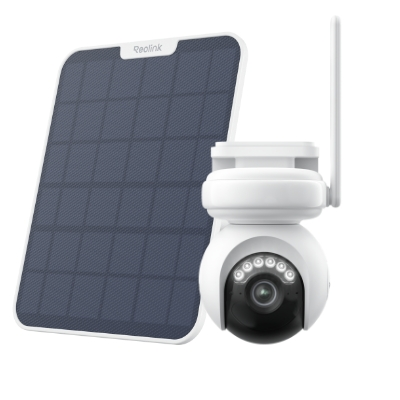How to Winterize an RV: Prepare Your RVs for Winter

Cold weather and falling temperatures can significantly affect the functionality of your RV. Hence, it is crucial to arrange for its winterization. If you are also among those who are searching for how to winterize an RV for winter living, do not look further.
Keep reading; the forthcoming content will introduce you to the ultimate guide to winterizing RVs, including its importance, preparation steps, and much more.
Reolink New Year Sale - Save Big with Exclusive Deals!
Save big with Reolink! New Year Sale up to 45% off on security cameras, doorbells, and systems — Dec. 8 to Jan. 4.
Why Need RV Winterization?
If you are concerned about your RV’s market value and robust functionalities, arranging for its winterization is crucial. Here are all the significant reasons to winterize rv.
- Preventing the damage: Extreme cold weather can create blockage in the water pipes and tanks, which can cause costly damage to your plumbing system. However, with winterization, you can prevent the situation.
- Prevention of mold growth: Proper winterization eliminates moisture from your RV’s interior and helps reduce the risk of mold and mildew growth.
- Protecting the exterior: Sealing and covering your RV protects it from the snow and enhances its durability.
Preparations for Winterizing an RV
Look at all the crucial points you must consider when preparing the RV for winterization.
When to Start?
Take account of the following factors to know the right time for winterization:
- Winterizing an RV is typically the right time when the outdoor temperature falls below 10 degrees C.
- As daylight hours reduce, it’s a sign to start winterization.
- Follow the local guidelines - if your area has any—to know the right time for RV winterization.
Tools and supplies
The following are all the necessary tools and supplies to winterize your RV.
- Antifreeze for the application
- Flashlight to look clearly
- Towels to wipe off the residue
- Use Bucket And bowls to collect the water
- Air compressor for the drainage.
- Screwdriver to tighten and loose nuts and bolts
Note: Cameras, including battery-powered security cameras, can function in winter. For example, the new Reolink Altas PT Ultra is perfect for outdoor use in any environments.
Industry-leading 4K Continuous Recording Battery Camera
4K UHD Continuous Recording; ColorX Night Vision; Pan & Tilt; Automatic Tracking; All Recordings Stored Locally.
How to Winterize an RV: Step-by-Step Guide
Being careful during winterization is integral to ensure its top-notch condition in winter. Here is a proper guide to winterize your RV:
1. Drain freshwater and wastewater
Empty all the water tanks, including the fresh water tank, gray tank, and black tank. Open all the faucets, and the water should flow out. This will help prevent the remaining water from causing damage after freezing.
2. Blow out water lines
Use compressed air to remove remaining water droplets and moisture from pipes. Connect the compressor and pressurize the system. Winterizing an RV with compressed air involves letting the air pressure dry out all the water in pipes and faucets.
3. Add antifreeze to the plumbing system
Antifreeze is a material that forms a thin layer and prevents moisture and water droplets from passing by and causing damage.
Pour the antifreeze into the tank and run it through faucets, showers, and toilets. Also, run it through all the other places where you think water is present, like traps under the sinks and showers, to prevent freezing.
4. Seal windows and doors
Inspect openings like windows, doors, and gaps. Apply sealant to all areas where you think cold can enter. This is necessary to protect your RV interior from harsh weather elements, so do not miss it.
5. Cover the roof and tires
Place covers on tires and other valuable items. These covers will shield against cracking and deterioration from ultraviolet rays. Use a roof cover to prevent snow and ice crystals from entering, building up, and causing potential damage.
6. Remove valuables and food
Remove all food items, personal belongings, and valuable components from the RV. Do not forget to empty your fridge to prevent odor and potential damage during the winter months.
7. Add fuel stabilizer for the engine
If the vehicle has a diesel engine, add a stabilizer. This will prevent the fuel from degrading over time and maintain the engine’s smoothness when you reuse it. You can ask for help from battery providers to get an accurate stabilizer for your RV engine.
8. Disconnect and store RV batteries.
Disconnect the batteries from the RV and store them in a cool and dry place. However, maintain an optimal charging level before storing them to not compromise their health.
9. Choose a storage location
Lastly, carefully analyze and store the available spaces in a covered space. If you plan to use an outdoor space, use a high-quality RV to protect your vehicle from snow, ice, and UV rays.
How to De-Winterize an RV?
It is equally important to properly de-winterize the RV as it is to winterize an RV. Here is a step-by-step guide to help you safely and effectively de-winterize your RV:
- Remove the Antifreeze: Flush out the plumbing system to remove the antifreeze you applied during the winterization. Open all the faucets and thoroughly run water through the system until the antifreeze is completely flushed out.
- Refill the tank: Refill the fresh water tank after checking for potential leakages and issues. Ensure that the water is functioning correctly.
- Reconnect batteries: Check your RV battery to see if it functions. If it is, clean the corrosion and reconnect it to the vehicle.
- Sanitize the water system: Sanitize the water system through the water purification solution.
- Check tire pressure: Remove the covers from the roof, tires, and exterior, and inspect if the tires are in good condition. They must not be inflated.
- Test appliances: Switch on the refrigerator and other appliances and check if they work fine.
- Stock up and prepare: Restock the RV with all the necessary materials, including food, personal care items, and other supplies for a comfortable trip.
How Much Does It Cost to Winterize an RV?
The cost of winterizing an RV depends on whether you do it yourself or hire a professional. If you plan to do it yourself, the cost is minimal.
You only need to purchase the necessary supplies like antifreeze for an RV, which costs around $10 to $30 per gallon. Now, it depends on the size and type of your RV and how much of the substance you would have to buy.
Next, you need roof and tire coverings, other cleaning supplies, and tools. You can add up around $20 to $50 for that. Thus, the total cost of winterizing an RV alone would be less than $100.
However, if you plan to hire a professional, expect to pay between $100 to $300. This usually covers the charges for essential supplies and other stuff.
FAQs
At what temperature does an RV need to be winterized?
You must winterize the RV when the temperature falls below 0 degrees C. Remember, freezing temperatures can freeze water in pipes and tanks. Hence, you must winterize your vehicle before this happens because once the water is frozen, you must also arrange for its melting.
Do you leave faucets open after winterizing the RV?
Yes, you leave the faucets open after winterizing the RV to let the remaining water run out. This ensures that the antifreeze is fully distributed throughout the system. Closing the faucets before water runs out can cause the residual to freeze in the faucet, creating long-lasting plumbing problems.
How cold is too cold to sleep in a camper?
You can sleep in the camper until the temperature is equal to or below -6 Celsius. However, if the temperature falls below that, sleeping in the camper is unsafe and may require heaters.
Conclusion
Freezing an RV prevents its functionality and market value from deteriorating in freezing climatic conditions. However, before you do it, it is integral to know the right way, which we have discussed in the guide above.
So, make sure to read it thoroughly and reap maximum benefits. If you find the guide helpful, share it with your family and friends, and let us know your opinions in the comments section below.
Search
Subscribe for the Latest Updates
Security insights & offers right into your inbox






























































































































































